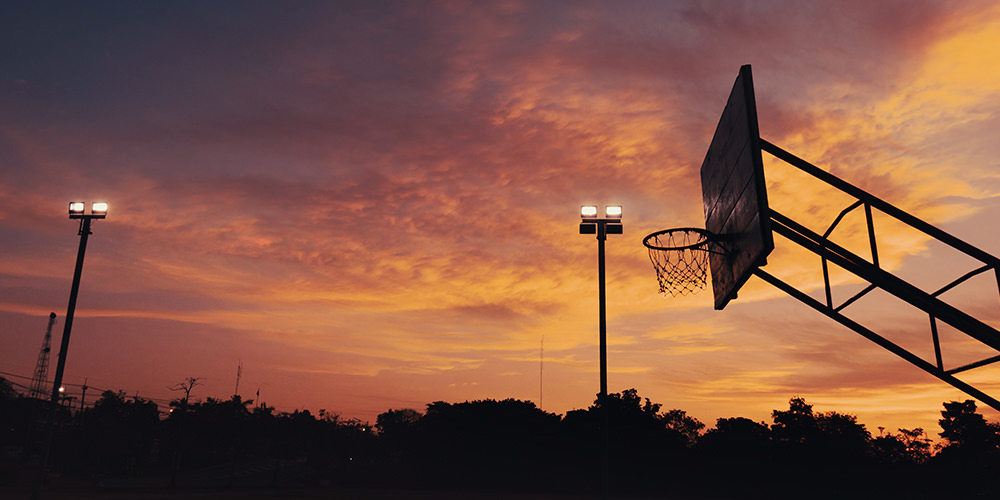
Basketball has experienced a remarkable global development process, spreading its popularity to every corner of the world. From its humble beginnings in North America, the sport has transcended borders and cultures. International organizations like FIBA, along with the inclusion of basketball in the Olympic Games, have played a significant role in its worldwide growth. The establishment of professional leagues, particularly the NBA, has further fueled the sport's global appeal. Today, basketball is celebrated and enjoyed by millions, uniting people through a shared love for the game and showcasing the power of sport to bring communities together.
Key considerations for basketball court lighting
Proper lighting is essential for basketball courts, ensuring optimal visibility for players and spectators. In this comprehensive guide, we will explore key considerations for basketball court lighting, from wattage selection to color rendering and energy efficiency.
Glare Reduction
Glossy finishes on indoor basketball courts can cause glare from lighting fixtures, affecting players' performance. Opt for glare-reducing lights with shields, and consider LED high bay options for even light distribution and reduced glare on glossy surfaces.
Color Rendering
Choose cooler tones, such as bluish-white or white, for better basketball lighting. These tones create a visually appealing focal point and a brighter look. LED high bay lighting is recommended for improved color rendering compared to traditional metal halide fixtures.
Flicker-Free Lighting
In professional basketball arenas, lighting must account for broadcast cameras. Ensure that the lights support a high frame rate (at least 6,000 frames per second) with a flicker rate of less than 0.3% to prevent flickering or strobe effects on high-speed cameras.
Energy Efficiency
Basketball arenas consume a significant amount of power for lighting. LED lights offer higher energy efficiency, saving nearly 50% in energy costs while maintaining the same level of brightness as traditional lights.
LUX Levels
LUX levels measure the intensity of light and are crucial for basketball court lighting. For non-televised events, a standard of 200 LUX is suitable for a standard-sized court. Televised events require a higher standard of 2,000 LUX to meet broadcast standards.
Proper Placement
Ensure that the most concentrated point of illumination falls outside of the field of play. This prevents interference with players' visibility and provides adequate illumination for the entire court.
(1) Outdoor basketball court lighting should be placed to minimize glare for players and spectators. Typically, lighting fixtures are positioned on both sides of the court.
Since outdoor courts have lower lighting requirements, fewer lamps are usually used. The installation height is an important consideration to avoid creating glare when athletes are running on the court. It is also important to consider light pollution and its impact on nearby areas.
Common outdoor basketball court lighting arrangements include Pole-mounted lighting; Overhead lighting; and Combination lighting.
(2) Indoor basketball court lighting can be arranged in three main ways:
- Side arrangement of lamps: LED lamps are placed on both sides of the venue, with the beams generally not directly above the court. This arrangement is suitable for Class II and Class I basketball court lighting. It is important to ensure uniform lighting and control glare.
- Top arrangement of lamps above the venue: This arrangement is more economical and suitable for low-ceiling sports venues. However, it may result in lower vertical illumination and less three-dimensional effect, with more noticeable shadows. It is typically used for Class III basketball courts.
- Mixed lighting arrangement: This arrangement combines top and side arrangements. It is generally suitable for multi-purpose stadiums where a balanced ratio of horizontal and vertical lighting can be achieved.
Special attention should be given to the use of asymmetric light distribution lamps for both side and mixed arrangements. These lamps are suitable for venues with high vertical lighting requirements and high TV broadcast standards. To control glare in side and mixed arrangements, it is recommended to aim the lamps at an angle not greater than 60 degrees, as specified by FIBA.
By following these guidelines for basketball court lighting design, both indoor and outdoor courts can achieve optimal visibility, reduce glare, and enhance the overall basketball experience for players and spectators. The right lighting enhances visibility, reduces glare, and contributes to the success of basketball games worldwide.












